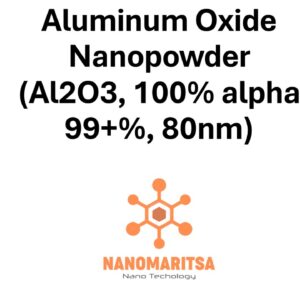Titanium Oxide Nanopowder (TiO2, rutile, high purity, 99.9+%, 50nm)
€70.00
CompareTitanium oxide nanopowder (TiO2, rutile, high purity, 99.9+, 50nm) is a premium-grade material characterized by its high purity and large particle size. The rutile phase of TiO2 is known for its excellent stability, optical properties, and photocatalytic activity, which makes it a valuable component in various industrial, environmental, and technological applications. This nanopowder, with a particle size of 50 nanometers and a purity exceeding 99.9%, is ideal for demanding uses that require high-performance material characteristics.
Composition and Structure
TiO2 (Titanium Dioxide):
Titanium dioxide is a compound composed of titanium and oxygen, and it is widely used due to its high refractive index, non-toxic nature, and exceptional durability. It is frequently used in pigment production, photocatalysis, and energy technologies.
Rutile Phase:
The rutile form of TiO2 is the thermodynamically stable crystalline structure of titanium dioxide. It is characterized by its high refractive index and dense nature, making it particularly useful in applications requiring optical properties, as well as superior photocatalytic capabilities under UV light.
Purity (99.9+%):
The material’s high purity ensures that it contains minimal impurities, providing consistent performance in sensitive applications where impurities might affect the material’s functionality.
Particle Size (50 nm):
The 50 nm particle size of this TiO2 nanopowder strikes a balance between surface area and stability, offering effective photocatalytic activity and the potential for use in applications requiring controlled particle size.
Properties
- Photocatalytic Activity:
Rutile TiO2, while not as highly photocatalytically active as the anatase form, still provides significant photocatalytic performance, especially when exposed to UV light. This makes it suitable for environmental applications such as pollutant degradation in water and air purification. - Optical Properties:
The high refractive index of rutile TiO2 makes it an excellent material for use in optical coatings, sunscreens, and pigments. It provides high brightness and opacity, as well as effective UV light absorption. - High Durability and Stability:
The rutile phase is highly stable under harsh conditions, including high temperatures and exposure to UV radiation, which gives TiO2 rutile nanopowder a long-lasting effect in various applications. - UV Absorption:
TiO2 rutile absorbs UV light efficiently, making it effective in UV-blocking applications such as in sunscreens, coatings, and filters for preventing UV radiation damage. - Electrical Properties:
TiO2 can also exhibit some electrical conductivity, which makes it suitable for use in electronics and energy storage devices, although its conductivity is generally lower than that of its anatase counterpart.
Applications
1. Environmental and Energy Applications:
Photocatalysis for Pollution Control:
Rutile TiO2 is commonly used for photocatalytic degradation of organic pollutants under UV light, making it a crucial material for environmental remediation processes such as wastewater treatment and air purification.
Water Treatment:
Its photocatalytic properties allow it to degrade toxic substances in water, such as dyes, pesticides, and pharmaceuticals, ensuring cleaner water in industrial and municipal water treatment systems.
Solar Energy Conversion:
TiO2 rutile is also employed in dye-sensitized solar cells (DSSCs), where it plays a key role in the conversion of light into electricity. The material’s high stability and efficient charge separation properties contribute to the performance of these renewable energy technologies.
Hydrogen Production:
TiO2 rutile is involved in photocatalytic water splitting to generate hydrogen, a promising clean energy source.
2. Pigments and Coatings:
White Pigments:
Rutile TiO2 is the most widely used white pigment in coatings, paints, and plastics due to its excellent opacity, brightness, and non-toxic nature. It ensures high-quality and long-lasting colors.
Protective Coatings:
TiO2 rutile is used in coatings that provide protection from UV degradation, corrosion, and wear. It is utilized in automotive, construction, and industrial coatings, offering both protective and aesthetic benefits.
Self-Cleaning Surfaces:
Due to its photocatalytic properties, TiO2 rutile is incorporated into self-cleaning surfaces that use sunlight to break down organic contaminants, keeping surfaces cleaner without the need for chemical cleaning agents.
3. Electronics and Sensors:
Electronics and Semiconductor Devices:
Rutile TiO2’s ability to conduct electricity under certain conditions makes it suitable for use in electronic devices, including sensors and semiconductors, where it can be used to detect environmental changes such as gas concentrations and temperature variations.
Energy Storage:
TiO2 is also integrated into energy storage systems, including batteries and supercapacitors, where it enhances stability and performance, particularly in high-capacity energy devices.
4. Cosmetics and Personal Care:
Sunscreens and UV Protection:
TiO2 rutile is commonly used in sunscreens as a UV filter to protect the skin from harmful rays. Its ability to scatter and absorb UV radiation makes it an ideal ingredient in personal care products.
Cosmetic Pigments:
Its white opacity and non-toxic properties make TiO2 rutile a popular choice in cosmetics and personal care products, including foundations, powders, and lotions.
Safety and Handling
Health Considerations:
Titanium dioxide is generally considered safe for use in consumer products. However, as with all nanopowders, safety measures should be followed during handling. It is advised to avoid inhalation or skin contact and to use appropriate protective equipment, including gloves, masks, and goggles.
Environmental Impact:
TiO2 rutile is non-toxic and environmentally friendly, but ongoing research is necessary to assess the long-term effects of nanoparticles on ecosystems. Ensuring that nanopowders do not accumulate in the environment is important for sustainable use.
Summary
Titanium oxide nanopowder (TiO2, rutile, high purity, 99.9+, 50nm) is a versatile material with numerous applications in industries such as environmental protection, energy, coatings, electronics, and personal care. Its high purity, excellent optical properties, UV absorption ability, and photocatalytic activity make it a key material in technologies ranging from solar energy conversion to pollution control. The rutile phase, with its stability and durability, ensures that TiO2 nanopowder meets the demands of advanced applications, offering long-lasting performance in a wide range of products and systems.
| Measurement (gr) | 100 grams, 500 grams, 1000 grams |
|---|






